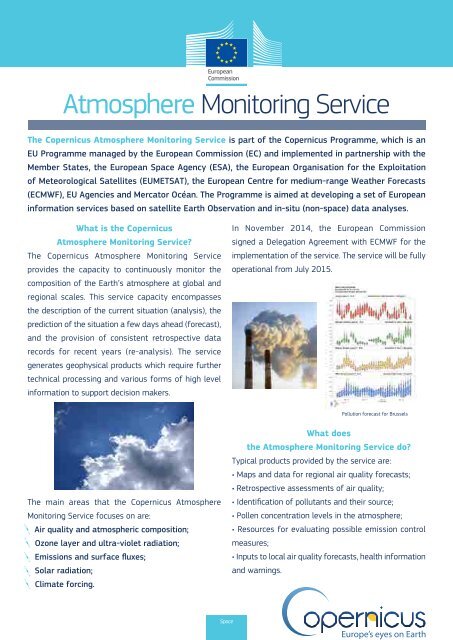Sentinel 2A Launch
Sentinel 2A Launch
Sentinel 2A Launch
You also want an ePaper? Increase the reach of your titles
YUMPU automatically turns print PDFs into web optimized ePapers that Google loves.
Atmosphere Monitoring Service<br />
The Copernicus Atmosphere Monitoring Service is part of the Copernicus Programme, which is an<br />
EU Programme managed by the European Commission (EC) and implemented in partnership with the<br />
Member States, the European Space Agency (ESA), the European Organisation for the Exploitation<br />
of Meteorological Satellites (EUMETSAT), the European Centre for medium-range Weather Forecasts<br />
(ECMWF), EU Agencies and Mercator Océan. The Programme is aimed at developing a set of European<br />
information services based on satellite Earth Observation and in-situ (non-space) data analyses.<br />
What is the Copernicus<br />
Atmosphere Monitoring Service?<br />
The Copernicus Atmosphere Monitoring Service<br />
provides the capacity to continuously monitor the<br />
composition of the Earth’s atmosphere at global and<br />
regional scales. This service capacity encompasses<br />
the description of the current situation (analysis), the<br />
prediction of the situation a few days ahead (forecast),<br />
and the provision of consistent retrospective data<br />
records for recent years (re-analysis). The service<br />
generates geophysical products which require further<br />
technical processing and various forms of high level<br />
information to support decision makers.<br />
The main areas that the Copernicus Atmosphere<br />
Monitoring Service focuses on are:<br />
Air quality and atmospheric composition;<br />
Ozone layer and ultra-violet radiation;<br />
Emissions and surface fluxes;<br />
Solar radiation;<br />
Climate forcing.<br />
Space<br />
In November 2014, the European Commission<br />
signed a Delegation Agreement with ECMWF for the<br />
implementation of the service. The service will be fully<br />
operational from July 2015.<br />
Pollution forecast for Brussels<br />
What does<br />
the Atmosphere Monitoring Service do?<br />
Typical products provided by the service are:<br />
• Maps and data for regional air quality forecasts;<br />
• Retrospective assessments of air quality;<br />
• Identification of pollutants and their source;<br />
• Pollen concentration levels in the atmosphere;<br />
• Resources for evaluating possible emission control<br />
measures;<br />
• Inputs to local air quality forecasts, health information<br />
and warnings.<br />
Some examples:<br />
Air Quality<br />
The Copernicus Atmosphere Monitoring<br />
Service provides continuous observation of<br />
the composition of the Earth’s atmosphere<br />
and helps predict air quality. Atmospheric<br />
composition helps to understand phenomena<br />
such as desert dust plumes, long-range<br />
transport of atmospheric pollutants including<br />
pollen as well as ash plumes from volcanic<br />
eruptions. This information can be relevant<br />
for different domains such as public health<br />
or even safety of air traffic.<br />
Each day, the Copernicus Atmosphere<br />
Monitoring Service provides analyses and<br />
forecasts detailing constituents in the Earth’s<br />
atmosphere at various heights above sea<br />
level for the next 96 hours.<br />
Solar Radiation<br />
The Service also monitors levels of UV<br />
radiation and provides 4-day forecasts<br />
on a European and global scale, which<br />
helps optimise the use of solar energy and<br />
supports the prevention of skin cancer.<br />
What is the added value of<br />
the Copernicus<br />
Atmosphere Monitoring Service?<br />
• The service delivers information on the air<br />
we breathe;<br />
• The recording and analysis of solar<br />
radiation provides information to public and<br />
private organisations in fields such as health,<br />
agriculture and solar energy;<br />
• The service compiles emission data and<br />
also estimates net fluxes of CO 2<br />
and CH 4<br />
at the Earth’s surface. This helps improve<br />
understanding of key climate forcings;<br />
• Freely available high quality data opens new<br />
possibilities in monitoring the composition<br />
of the atmosphere and enables the creation<br />
of new business ideas supporting public<br />
and private stakeholders in a wide area of<br />
applications linked to atmospheric science.<br />
The Copernicus data policy promotes the<br />
access, use and sharing of Copernicus<br />
information and data on a full, free and<br />
open basis.<br />
Surface Carbon Monoxide<br />
Total Aerosol Optical Depth<br />
Surface parameter:<br />
Nitrogen dioxide<br />
Average of Observed<br />
Fire Radiative<br />
Power Areal Density<br />
Co 2 concentration over Africa<br />
Global nitrogen oxides<br />
Users can find out more about the products delivered by the Copernicus Atmosphere Monitoring Service at: http://atmosphere.copernicus.eu<br />
Photo credits: Atmosphere ©FDC; Smokestacks Istock ©Mykhailo Shcherbyna; All the maps are provided by the maps are provided by ©the EU-funded FP7 project MACC-II.


